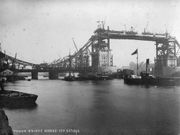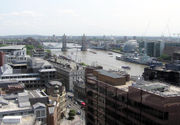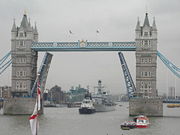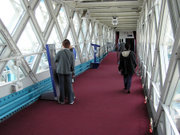Tower Bridge
2008/9 Schools Wikipedia Selection. Related subjects: Engineering
| Tower Bridge | |
|---|---|
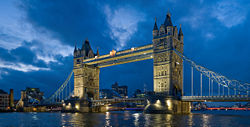 Tower Bridge from the North Bank at dusk |
|
| Carries | A100 Tower Bridge Road - motor vehicles, pedestrians |
| Crosses | Thames |
| Locale | London |
| Maintained by | Bridge House Estates |
| Design | Bascule bridge, suspension bridge |
| Longest span | 61 m (200 ft) |
| Total length | 244 m (800 ft) |
| Clearance below | 8.6 m (closed), 42.5 m (open) |
| Opening date | 30 June 1894 |
Tower Bridge is a combined bascule and suspension bridge in London, England over the River Thames. It is close to the Tower of London, which gives it its name. It has become an iconic symbol of London. Tower Bridge is one of several London bridges owned and maintained by the City Bridge Trust, a charitable trust overseen by the City of London Corporation.
Tower Bridge is sometimes mistakenly referred to as London Bridge, which is actually the next bridge upstream. A popular urban legend is that, in 1968 Robert McCulloch, the purchaser of the old London Bridge which was later shipped to Lake Havasu City, Arizona, believed mistakenly that he was buying Tower Bridge, but this was denied by McCulloch himself and has been debunked by Ivan Luckin, the seller of the bridge.
Design
In the second half of the 19th century, increased commercial development in the East End of London led to a requirement for a new river crossing downstream of London Bridge. A traditional fixed bridge could not be built because it would cut off access to the port facilities in the Pool of London, between London Bridge and the Tower of London.
A Special Bridge or Subway Committee was formed in 1876, chaired by A. J. Altman, to find a solution to the river crossing problem. It opened the design of the crossing to public competition. Over 50 designs were submitted, including one from civil engineer Sir Joseph Bazalgette. The evaluation of the designs was surrounded by controversy, and it was not until 1884 that a design submitted by Horace Jones, the City Architect (who was also one of the judges), was approved.
Jones' engineer, Sir John Wolfe Barry devised the idea of a bascule bridge 800 feet (244 m) in length with two towers each 213 feet (65 m) high, built on piers. The central span of 200 feet (61 m) between the towers was split into two equal bascules or leaves, which could be raised to an angle of 83 degrees to allow river traffic to pass. The bascules, weighing over 1,000 tons each, were counterbalanced to minimize the force required and allow raising in five minutes.
The two side-spans are suspension bridges, each 270 feet (82 m) long, with the suspension rods anchored both at the abutments and through rods contained within the bridge's upper walkways. The pedestrian walkways are 143 feet (44 m) above the river at high tide.
Construction started in 1886 and took eight years with five major contractors – Sir John Jackson (foundations), Baron Armstrong (hydraulics), William Webster, Sir H.H. Bartlett, and Sir William Arrol & Co. – and employed 432 construction workers. E W Crutwell was the resident engineer for the construction.
Two massive piers, containing over 70,000 tons of concrete, were sunk into the river bed to support the construction. Over 11,000 tons of steel provided the framework for the towers and walkways. This was then clad in Cornish granite and Portland stone, both to protect the underlying steelwork and to give the bridge a pleasing appearance.
Jones died in 1887, and George D. Stevenson took over the project. Stevenson replaced Jones' original brick facade with the more ornate Victorian Gothic style that makes the bridge a distinctive landmark, and was intended to harmonise the bridge with the nearby Tower of London.
The bridge was officially opened on 30 June 1894 by the Prince of Wales, the future King Edward VII, and his wife, Alexandra of Denmark.
The bridge connected Iron Gate, on the north bank of the river, with Horsleydown Lane, on the south – now known as Tower Bridge Approach and Tower Bridge Road, respectively. It largely replaced Tower Subway, 400 m to the west, the world's first underground railway (1870). Until the bridge was opened, the subway was the shortest way to cross the river from Tower Hill to Tooley Street in Southwark.
The total cost of construction was £1,184,000.
Hydraulic system
The original raising mechanism was powered by pressurised water stored in six hydraulic accumulators.
The system was designed and installed by Sir W. G. Armstrong Mitchell & Company of Newcastle upon Tyne. Water, at a pressure of 750 psi, was pumped into the accumulators by two 360 hp stationary steam engines, each driving a force pump from its piston tail rod. The accumulators each comprise a 20-inch ram on which sits a very heavy weight to maintain the desired pressure.
In 1974, the original operating mechanism was largely replaced by a new electro-hydraulic drive system, designed by BHA Cromwell House. The only components of the original system still in use are the final pinions, which engage with the racks fitted to the bascules. These are driven by modern hydraulic motors and gearing, using oil rather than water as the hydraulic fluid.
Some of the original hydraulic machinery has been retained, although it is no longer in use. It is open to the public and forms the basis for the bridge's museum, which resides in the old engine rooms on the south side of the bridge. The museum includes the steam engines, two of the accumulators and one of the hydraulic engines that moved the bascules, along with other related artefacts.
The third steam engine
During World War II, as a precaution against the existing engines being damaged by enemy action, a third engine was installed in 1942. This was a 150 hp horizontal cross-compound engine built by Vickers Armstrong Ltd., at their Elswick works in Newcastle-upon-Tyne. It was fitted with a 9 feet diameter flywheel weighing 9 tons, and was governed to a speed of 30 rpm.
The engine became redundant when the rest of the system was modernised in 1974, and was donated to the Forncett Industrial Steam Museum by the Corporation of the City of London.
Navigation control
To control the passage of river traffic through the bridge, a number of different rules and signals were employed. Daytime control was provided by red semaphore signals, mounted on small control cabins on either end of both bridge piers. At night, coloured lights were used, in either direction, on both piers: two red lights to show that the bridge was closed, and two green to show that it was open. In foggy weather, a gong was sounded as well.
Vessels passing through the bridge had to display signals too: by day, a black ball at least 2 feet (0.61 m) in diameter was to be mounted high-up where it could be seen; by night, two red lights in the same position. Foggy weather required repeated blasts from the ship's steam whistle.
If a black ball was suspended from the middle of each walkway (or a red light at night) this indicated that the bridge could not be opened. These signals were repeated about 1,000 yards (910 m) downstream, at Cherry Garden Pier, where boats requiring to pass through the bridge had to hoist their signals/lights and sound their horn, as appropriate, to alert the Bridge Master.
Some of the control mechanism for the signalling equipment has been preserved and may be seen working in the bridge's museum.
Reaction
Although the bridge is an undoubted landmark, professional commentators in the early 20th century were critical of its aesthetics. "It represents the vice of tawdriness and pretentiousness, and of falsification of the actual facts of the structure", wrote H. H. Statham, while Frank Brangwyn stated that "A more absurd structure than the Tower Bridge was never thrown across a strategic river".
Architectural historian Dan Cruickshank selected the bridge as one of his four choices for the 2002 BBC television documentary series Britain's Best Buildings.
Incidents
At 21:35 on 30 December 1952, a crowded double-decker London bus (an RT), on route 78 to Dulwich, jumped over the gap when the bridge started to open while it was halfway across.
On 5 April 1968 a Hawker Hunter FGA.9 jet fighter from No.1 Squadron RAF, flown by Flt Lt Al Pollock, flew under Tower Bridge. Unimpressed that senior staff were not going to celebrate the RAF's 50th birthday with a fly-past, Pollock decided to do something himself. Without authorisation, Pollock flew the Hunter at low level down the Thames, past the Houses of Parliament, and continued on to Tower Bridge. He flew the Hunter beneath the bridge's walkway, remarking afterwards it was an afterthought when he saw the bridge looming ahead of him. Pollock was placed under arrest upon landing, and discharged from the RAF on medical grounds without the chance to defend himself at a court martial. (See also: Hawker Hunter Tower Bridge incident.)
In May 1997, the motorcade of United States President Bill Clinton was divided by the 'unexpected' opening of the bridge. Thames sailing barge Gladys, on her way to a gathering at St Katharine Docks, arrived on schedule and the bridge was duly opened for her. Returning from a Thames-side lunch at Le Pont de la Tour restaurant, with UK Prime Minister Tony Blair, President Clinton was less punctual, and arrived just as the bridge was rising. The bridge opening split the motorcade in two, much to the consternation of security staff. A spokesman for Tower Bridge is quoted as saying, 'We tried to contact the American Embassy, but they wouldn't answer the 'phone.'
On 19 August 1999, Jef Smith, a Freeman of the City of London, drove a 'herd' of two sheep across the bridge. He was exercising an ancient permission, granted as a right to Freemen, to make a point about the powers of older citizens and the way in which their rights were being eroded.
Tower Bridge today
Road traffic
Tower Bridge is still a busy and vital crossing of the Thames: it is crossed by over 40,000 people (motorists and pedestrians) every day. The bridge is on the London Inner Ring Road, and (as of 2007) is on the eastern boundary of the London congestion charge zone. (Drivers do not incur a charge by crossing the bridge.)
In order to maintain the integrity of the historic structure, the City of London Corporation have imposed a 20 miles per hour (32 km/h) speed restriction, and an 18 ton weight limit on vehicles using the bridge. A sophisticated camera system measures the speed of traffic crossing the bridge, utilising a number plate recognition system to send fixed penalty charges to speeding drivers.
A second system monitors other vehicle parameters. Induction loops and piezo-electric detectors are used to measure the weight, the height of the chassis above ground level, and the number of axles for each vehicle.
River traffic
The bascules are raised around 1000 times a year. River traffic is now much reduced, but it still takes priority over road traffic. Today, 24 hours' notice is required before opening the bridge.
A computer system was installed in 2000 to control the raising and lowering of the bascules remotely. Unfortunately it proved less reliable than desired, resulting in the bridge being stuck in the open or closed positions on several occasions during 2005, until its sensors were replaced.
Tower Bridge Exhibition
The high-level walkways between the towers gained an unpleasant reputation as a haunt for prostitutes and pickpockets and were closed in 1910. In 1982 they were reopened as part of the Tower Bridge Exhibition, an exhibition now housed in the bridge's twin towers, the high-level walkways and the Victorian engine rooms. The walkways boast stunning views of the River Thames and many famous London sites, serving as viewing galleries for over 380,000 tourists who visit each year. The exhibition also uses films, photos and interactives to explain why and how Tower Bridge was built. Visitors can access the original steam engines that once powered the bridge bascules, housed in a building close to the south end of the bridge.
A Behind the Scenes tour can be booked in advance, during which it is possible to see the bridge's command centre, from where the raising of the bascules is controlled for a vessel to pass through, and go down into the bascule chambers too.
2008-2012 facelift
In April 2008 it was announced that the bridge will undergo a 'facelift' costing £4m, and taking four years to complete. The work entails stripping-off the existing paint and repainting in blue and white. Each section will be enshrouded in scaffolding to prevent the old paint falling into the Thames causing pollution. Starting in summer 2008, contractors will work on a quarter of the bridge at a time to minimise disruption, but some road closures are inevitable. The bridge will remain open until winter 2010, but is then expected to be closed for several months. It is hoped that the completed work will last 25 years.

